https://docs.google.com/present/edit?id=0AbOLKQ13DbWNZGdnc3NxbXdfMjVmbnA0dzRjZA&hl=zh_TW
Permanent link to this article: http://interface2011.coin-operated.com/2011/10/stranger-project-choose-path-update/
Oct 23
Instruction Set for Strangers- DAY 1 (continued)
-Our First Initial Mock-Ups Launched-
We stuck with the animated characters to humanize the items in order to enhance the eco-scavenger hunt appeal, giving it more of a fun factor in hopes that the interaction experience would also be a fun one as well as educational.
We decided on a family model to introduce the recyclable items and make them into a more cohesive group.
We decided on three sets of items at 4 each. One group would be the coffee cups, 2nd would be plastic bottles and 3rd would be glass bottles.
Taped and inside these items contains a map where it would lead to each different character that must be collected.
We eventually hid the items into where they were to be found (indicated on the map).
Video: observation of the project.
Permanent link to this article: http://interface2011.coin-operated.com/2011/10/instruction-set-for-strangers-day-1-continued/
Permanent link to this article: http://interface2011.coin-operated.com/2011/10/instructions-presentation-2/
Oct 19
instruction sets for strangers
Group: Sable Smith, Elizabeth Tolson, Rachel Law
Location Washington Square Park
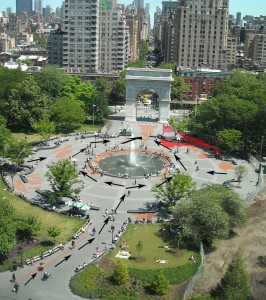
Above is a map that was created from the sat. documentation.
Video Documentation
We decided upon Washington Square Park because of the highly contrasted demographic that its location allows for.
There is a mixture of NYU students and faculty, the crowd attracted by the east village, street performers and artist, tourist, and the locals from the surrounding neighborhood. This creates a rich mixture of culture and personality.
A few things that interest us about engaging within a space:
dialogue
communication
street performance
playing with scale/ the scale of objects, space, perspective, etc
the digital and physical and how they collide, interact, and negotiate with each other in the larger context of american society
Intervention Ideas:
tourist exploitation (best photo spot here)
Human powered shredder
Telephone game — (telephone rings, ask a question and answer is saved or broadcast, etc)
Permanent link to this article: http://interface2011.coin-operated.com/2011/10/instruction-sets-for-strangers-2/
Permanent link to this article: http://interface2011.coin-operated.com/2011/10/instruction-set-for-strangers-mock-ups-continued/
Permanent link to this article: http://interface2011.coin-operated.com/2011/10/instruction-sets-site-analysis-presentation/
Permanent link to this article: http://interface2011.coin-operated.com/2011/10/american-purge-location-documentation/
Oct 17
Commentary on “The social life of small urban spaces”
The first thing that caught my attention was that it is in fact harder to construct dysfunctional public spaces. Zoning, designing policies, new guidelines and rules are just abstract documents without careful observation of human interaction with his surroundings. The case of the playground chosen by kids at east Harlem serves as an excellent example of organic findings and interaction of people and the city. If the rules, regulations and guidelines are not derived from behavioral patterns of a society, chances of building successful public spaces are next to nothing.
“Supply creates demand”. The more common space in the city, the more time will be spent in these public spaces, consequently changing the patterns of social life of people in the public real. It is amazing how by creating opportunities we can alter the social life and increase the presence of the public on the surface of our cities.
Some of the social notations made in the research appear to have lost validity over time. As an observer in New York City, personally, observations such as “girl watchers”, “men guarding the gates” and “women picking secluded areas” do not seem likely anymore. Let alone the “Sandwich and beer cans”. This goes to show, I believe, that the public behavior is affected by numerous equally important factors, predominantly culture, which in itself is thriving and ever-changing. An on-going change that with it, alters the rules of social conduct and behavioral patterns.
The fact that people claim they need a “refuge” or “oasis” from the crowd, while they actually tend not to – since plazas and other public spaces are mostly far from secluded – bring out a point also mentioned in the paper “Cultural Probes”. The uselessness of questionnaires in some cases stems from unawareness of people about what they actually “need”. This is where careful observation and probe steps in. Our awareness is so saturated by environmental stimulation that we might lose sight of what we need, or how we actually tend to behave on a daily basis.
What strikes me most about the reading “Sitting Spaces” is the conclusion “People tend to sit where there are places to sit”. Sure enough, this is no extraordinary conclusion. But it emphasizes on organic nature of the preference of the sitting crowd. Shape, amount of space, exposure to sun, visual richness are all proven to be of less importance, also the fact that constructing a more sit-able environment is actually lest costly, is a case of design by reduction, in which instead of thinking of adding accessories to a basic object, we can simplify and create fully functional objects that require less material and labor, and consequently, cost less.
On the dimensions of the sitting area, I found the steps most intriguing. The “Street view” and “Theater” analogy, the endless possibilities the steps provide, in terms of grouping, choice of spot, and naturally adjustable height makes steps nothing less than ideal sitting place.
In case of benches and how they have proven incompetent, I believe the architect here has been assuming total authority over the condition and quality of sitting of people. Dictating an design/object to users, in my opinion, does not happen to be the most efficient design methodology. It is only through careful study of behavior that a designer is able to delve deep into the needs of the audience, or better yet, through a participatory design methodology. Here, the example of “Chairs” clearly illustrate the prevail of flexible open-ended design that can be relocated, reshaped and reconstructed by users, versus the predefined rigid design of benches that dictate the condition, posture and whereabouts of the experience to the user.
The author makes a very crucial point bringing up the elevation of the park in relation to the street. Higher or lower parks and public places suffer from a poor visibility, and in most cases do not appear hospitable and inviting to the audience. One excellent exception is the High Line park in western Manhattan where an old abandoned freight rail track is redesigned to serve as a public park. Here, the rail tracks have been laid few feet above the ground, and still it hosts a great number of visitors everyday. Of course the curious nature of this shift in functionality of railroad structure makes an exceptional special case that attracts the attention.
All in all, in my opinion, a public space will not provide an amicable ambiance unless the designing/planning team carry out a thorough research on the behavioral patterns of the people who will ultimately be the occupants of these spaces, their needs, their possible interactions and the contexts in which they will eventually interact with each other, furniture, performers, etc.
Permanent link to this article: http://interface2011.coin-operated.com/2011/10/commentary-on-the-social-life-of-small-urban-spaces/
Permanent link to this article: http://interface2011.coin-operated.com/2011/10/the-high-line-time-sequence/
Permanent link to this article: http://interface2011.coin-operated.com/2011/10/strager-project-%ef%bd%97eek1-progress/















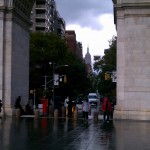
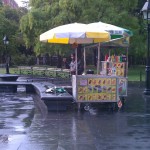

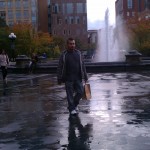
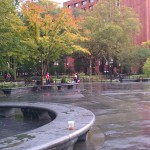
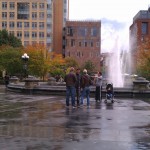





Comments!